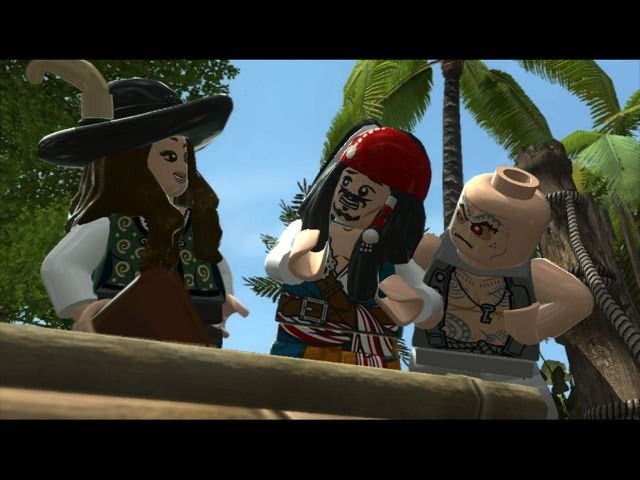Lego Pirates of the Caribbean
A Jerry Brickheimer production.
Frequently, it's simply a case of switching to the right character in the right location, but rather than just being handed the ship-in-the-bottle minikit piece you were after, often whole new areas will open up, hiding multiple secrets and unique asides. One of the later levels sees a mermaid's singing reveal the den of a large Lego spider which you then ride into battle against other arachnids. The same stage also carries a miniature ship skirmish where you steer your craft across a small pool, blasting enemy galleons with cannon fire.
Otherwise, it's that familiar blend of enjoyable, simple-minded combat, rudimentary puzzles and Lego-stud kleptomania. I don't know whether it's down to the noticeably improved game engine, but even Lego veterans may be surprised at just how many tiny shinies the game seems determined to hurl at the player.
Perhaps surprisingly, such a cascade of Lego bits doesn't seem to cause any kind of technical hiccup. Indeed, the tearing and slowdown that have blighted previous Lego games are conspicuous by their absence. Graphically, this is the most impressive in the series to date, with some exceptional lighting complementing the sun-kissed island environments and making the storm-lashed, seaborne set-pieces more visually exciting.

If Pirates seems less ambitious than the last two Lego titles, lacking the cohesiveness of Potter's Hogwarts hub or the epic scale of Clone Wars', um, wars, then it makes up for it with an overall confidence borne from TT Games' experience with the licence. The highlight of Dead Man's Chest - that three-way swordfight atop, around and inside a giant water wheel - probably wouldn't have been attempted a couple of years ago, but it's replicated here in all its remarkable silliness. It's arguably one of the few moments where the game's reach exceeds the developer's grasp, the sole occasion where the platforming feels a little awkward, but it's so audacious that you can't help but admire the effort.
Otherwise, everything feels that bit more polished. There are sticky platforms that make it harder to lose your footing, and while AI characters still have their moments - at one point I was convinced blacksmith Mr. Briggs was trying to parody Jacob's Ladder, though his rapid shaking was merely because he was stuck on a piece of scenery - for the most part their behaviour is a vast improvement on previous games. The lone player certainly won't be pining after the comparative reliability of a human partner quite so often.

It still irks me slightly that a game based on a construction toy spends more time on destruction, even if the compulsion to smash everything and siphon up those lovely studs remains so strong. One day, I'd love to play a Lego game that allows me to build anything I want, like that giant starship I built from four different sets of space Lego as a kid.
Until then, we have formulaic but tremendously enjoyable games like this - not that you can blame TT Games for sticking to the template that has brought millions of young gamers such enjoyment over the past few years. It's true that those who've played the last two or three Lego titles might experience a little déjà vu, but the rest will likely find that a pirate's life is very much for them. Savvy?

